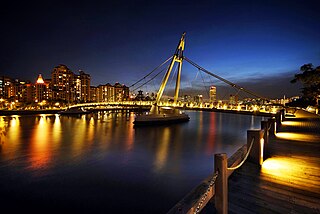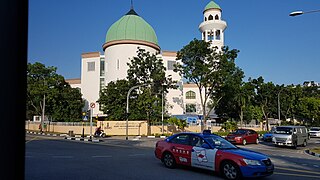
Geylang is a planning area and township located on the eastern fringe of the Central Region of Singapore, bordering Hougang and Toa Payoh in the north, Marine Parade in the south, Bedok in the east, and Kallang in the west.

The East Coast Parkway is a fully-controlled access expressway that runs along the southeastern coast of Singapore. It is approximately 16 kilometres (9.9 mi) in length. As of July 2022, it is Singapore's third-longest expressway. The expressway serves a vital function by being the primary highway from the airport to the central area.

Kallang (IPA:/kɑːlɑːŋ/ is a planning area and residential zone located in the Central Region of Singapore.
Simei is an estate located in Tampines Town in the Eastern Region of Singapore. The name Simei is pinyin for "Four Beauties" in Chinese. Formerly known as Tampines South, it was officially renamed to Simei in 1985.

Bedok is a planning area and residential town located in the geographical region of Tanah Merah along the south-eastern coast of the East Region of Singapore. Bedok is bounded by five other planning areas: Paya Lebar to the north, Hougang to the northwest, Tampines to the northeast and east, Geylang to the west and Marine Parade to the southwest. It also shares a maritime boundary with the Singapore Strait to the south and southeast.

The Pan Island Expressway is the oldest and longest expressway in Singapore. It is also Singapore's longest road. The expressway runs from the East Coast Parkway near Changi Airport in the east to Tuas in the west and has a total length of 42.8 kilometres.

The Seletar Expressway is a highway in Singapore that traverses the northern end of the island and joins the Central Expressway (CTE) and the Tampines Expressway (TPE) in Seletar to the Bukit Timah Expressway (BKE) in Kranji.
The following lists events that happened during 1996 in Singapore.

The Bukit Timah Satellite Earth Station is the second satellite earth station in Singapore after Sentosa Satellite Earth Station in Sentosa Island.

Geylang East, as a planning subzone, covers what is more commonly known as Eunos. This is located in Geylang zone in the Central Region of Singapore. The vicinity is served by both Paya Lebar and Eunos MRT stations. This area is distinct from the Geylang East Central and estate, which is adjacent to and west of Eunos.

Sir Laurence Nunns Guillemard was a British civil servant who served as high commissioner in Malaya when it was under the British Empire.
Bartley Road is a major road in Singapore extending from Upper Serangoon Road to Tampines Avenue 10. The road has a distance span of 5.8km. En route, it passes through the areas of Serangoon, Bartley, Paya Lebar, Defu, Kaki Bukit, and Bedok Reservoir.
Occasionally, some parts of Singapore are inundated by floods, usually in the form of flash floods that came about due to intense rainfall over a short period of time. Floods in Singapore are much less severe than floods in other countries, often only lasting a few hours before dissipating on its own.

Kaki Bukit MRT station is an underground Mass Rapid Transit (MRT) station on the Downtown line (DTL). Situated in Kaki Bukit, Singapore, it is located along Kaki Bukit Avenue 1. The station serves the vicinity's residential and industrial developments, including Kaki Bukit Techpark and TechView.

Kaki Bukit is an industrial area located in Bedok in the East Region of Singapore. It is home to many high tech industrial companies and warehouses. There used to be a prison complex called Kaki Bukit Centre, which was converted to a prison school in 2000. It has since moved to Tanah Merah and the Acacia Welfare Home now stands in its place. On the south of Kaki Bukit is Jalan Tenaga and Jalan Damai neighbourhoods of Bedok Reservoir Road. Redevelopments are in the pipeline for Kaki Bukit beyond 2030 when Paya Lebar Airbase, located just north of the estate, relocates to Changi. Not only would land be freed up for use but building height restrictions, that are currently in place for safety reasons because the estate is directly aligned with the airbase runway, would also be lifted. Kaki Bukit is classified by Urban Redevelopment Authority (URA) as a subzone under the planning area of Bedok, its boundaries differ from the constituency boundaries used by the Singapore Parliament.
David Joseph Murnane (1892–1953) was Singapore's longest serving municipal water engineer, serving from 1925 to 1947.
Robert Peirce was a British-born civil engineer who served as Municipal Engineer in Penang, Malaysia and Singapore.

Masjid Alkaff Kampung Melayu, is a mosque located on the junction of Kaki Bukit Avenue 1 and Bedok Reservoir Road in Bedok, Singapore. The institution mainly serves worshippers from the Bedok Reservoir area.
Geylang East Public Library is one of the 26 public libraries established by the National Library Board of Singapore.














